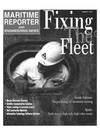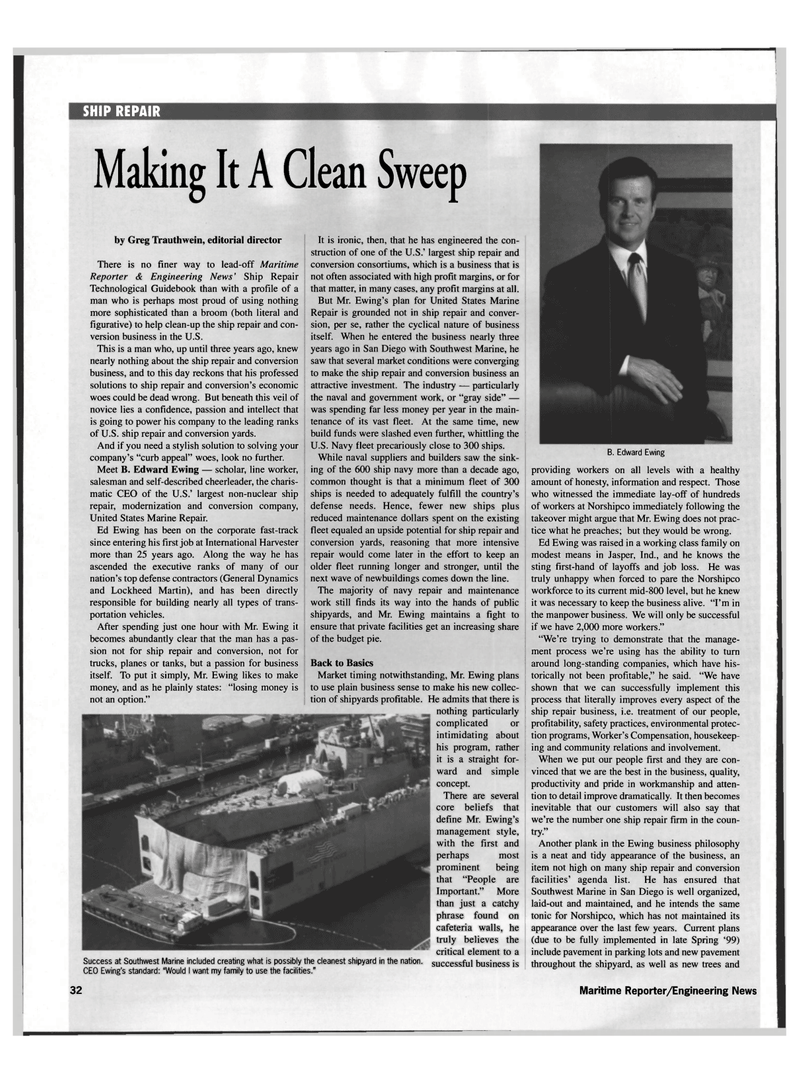
Page 32: of Maritime Reporter Magazine (March 1999)
Read this page in Pdf, Flash or Html5 edition of March 1999 Maritime Reporter Magazine
SHIP REPAIR
Making It A Clean Sweep
B. Edward Ewing
It is ironic, then, that he has engineered the con- struction of one of the U.S.' largest ship repair and conversion consortiums, which is a business that is not often associated with high profit margins, or for that matter, in many cases, any profit margins at all.
But Mr. Ewing's plan for United States Marine
Repair is grounded not in ship repair and conver- sion, per se, rather the cyclical nature of business itself. When he entered the business nearly three years ago in San Diego with Southwest Marine, he saw that several market conditions were converging to make the ship repair and conversion business an attractive investment. The industry — particularly the naval and government work, or "gray side" — was spending far less money per year in the main- tenance of its vast fleet. At the same time, new build funds were slashed even further, whittling the
U.S. Navy fleet precariously close to 300 ships.
While naval suppliers and builders saw the sink- ing of the 600 ship navy more than a decade ago, common thought is that a minimum fleet of 300 ships is needed to adequately fulfill the country's defense needs. Hence, fewer new ships plus reduced maintenance dollars spent on the existing fleet equaled an upside potential for ship repair and conversion yards, reasoning that more intensive repair would come later in the effort to keep an older fleet running longer and stronger, until the next wave of newbuildings comes down the line.
The majority of navy repair and maintenance work still finds its way into the hands of public shipyards, and Mr. Ewing maintains a fight to ensure that private facilities get an increasing share of the budget pie.
Back to Basics
Market timing notwithstanding, Mr. Ewing plans to use plain business sense to make his new collec- tion of shipyards profitable. He admits that there is nothing particularly complicated or intimidating about his program, rather it is a straight for- ward and simple concept.
There are several core beliefs that define Mr. Ewing's management style, with the first and perhaps most prominent being that "People are
Important." More than just a catchy phrase found on cafeteria walls, he truly believes the critical element to a
Success at Southwest Marine included creating what is possibly the cleanest shipyard in the nation, successful business is
CEO Ewing's standard: "Would I want my family to use the facilities." by Greg Trauthwein, editorial director
There is no finer way to lead-off Maritime
Reporter & Engineering News' Ship Repair
Technological Guidebook than with a profile of a man who is perhaps most proud of using nothing more sophisticated than a broom (both literal and figurative) to help clean-up the ship repair and con- version business in the U.S.
This is a man who, up until three years ago, knew nearly nothing about the ship repair and conversion business, and to this day reckons that his professed solutions to ship repair and conversion's economic woes could be dead wrong. But beneath this veil of novice lies a confidence, passion and intellect that is going to power his company to the leading ranks of U.S. ship repair and conversion yards.
And if you need a stylish solution to solving your company's "curb appeal" woes, look no further.
Meet B. Edward Ewing — scholar, line worker, salesman and self-described cheerleader, the charis- matic CEO of the U.S.' largest non-nuclear ship repair, modernization and conversion company,
United States Marine Repair.
Ed Ewing has been on the corporate fast-track since entering his first job at International Harvester more than 25 years ago. Along the way he has ascended the executive ranks of many of our nation's top defense contractors (General Dynamics and Lockheed Martin), and has been directly responsible for building nearly all types of trans- portation vehicles.
After spending just one hour with Mr. Ewing it becomes abundantly clear that the man has a pas- sion not for ship repair and conversion, not for trucks, planes or tanks, but a passion for business itself. To put it simply, Mr. Ewing likes to make money, and as he plainly states: "losing money is not an option." providing workers on all levels with a healthy amount of honesty, information and respect. Those who witnessed the immediate lay-off of hundreds of workers at Norshipco immediately following the takeover might argue that Mr. Ewing does not prac- tice what he preaches; but they would be wrong.
Ed Ewing was raised in a working class family on modest means in Jasper, Ind., and he knows the sting first-hand of layoffs and job loss. He was truly unhappy when forced to pare the Norshipco workforce to its current mid-800 level, but he knew it was necessary to keep the business alive. "I'm in the manpower business. We will only be successful if we have 2,000 more workers." "We're trying to demonstrate that the manage- ment process we're using has the ability to turn around long-standing companies, which have his- torically not been profitable," he said. "We have shown that we can successfully implement this process that literally improves every aspect of the ship repair business, i.e. treatment of our people, profitability, safety practices, environmental protec- tion programs, Worker's Compensation, housekeep- ing and community relations and involvement.
When we put our people first and they are con- vinced that we are the best in the business, quality, productivity and pride in workmanship and atten- tion to detail improve dramatically. It then becomes inevitable that our customers will also say that we're the number one ship repair firm in the coun- try."
Another plank in the Ewing business philosophy is a neat and tidy appearance of the business, an item not high on many ship repair and conversion facilities' agenda list. He has ensured that
Southwest Marine in San Diego is well organized, laid-out and maintained, and he intends the same tonic for Norshipco, which has not maintained its appearance over the last few years. Current plans (due to be fully implemented in late Spring '99) include pavement in parking lots and new pavement throughout the shipyard, as well as new trees and 32 Maritime Reporter/Engineering News

 31
31

 33
33
